Practical Approach for Defining the Sustainable Yield of Wells in Low-Permeability Fractured Rocks
Abstract
1. Introduction
2. Materials and Methods
2.1. Climatic and Geological Framework of the Test Sites
2.2. Hydrogeological Investigations
2.3. Processing Methods
3. Results
3.1. Geology and Hydrogeology of the Test Sites
3.2. Pumping Tests
4. Discussion on Aquifer and Well Response to Pumping
5. Operational Approach to Define the Sustainable Yield of a Single Well
6. Conclusions
Author Contributions
Funding
Data Availability Statement
Acknowledgments
Conflicts of Interest
References
- Alley, W.M.; Reilly, T.E.; Franke, O.L. Sustainability of Ground-Water Resources; U.S. Department of the Interior, U.S. Geological Survey: Reston, VA, USA, 1999; Volume 1186, pp. 1–79.
- Elshall, A.S.; Arik, A.D.; El-Kadi, A.I.; Pierce, S.; Ye, M.; Burnett, K.M.; Wada, C.A.; Bremer, L.L.; Chun, G. Groundwater sustainability: A review of the interactions between science and policy. Environ. Res. Lett. 2020, 15, 093004. [Google Scholar] [CrossRef]
- Misstear, B.D.R.; Beeson, S. Using operational data to estimate the reliable yields of water-supply wells. Hydrogeol. J. 2000, 8, 177–187. [Google Scholar] [CrossRef]
- Van Tonder, G.J.; Botha, J.F.; Chiang, W.H.; Kunstmann, H.; Xu, Y. Estimation of the sustainable yields of boreholes in fractured rock formation. J. Hydrol. 2001, 241, 70–90. [Google Scholar] [CrossRef]
- Beeson, S.; Misstear, B.D.R.; van Wonderen, J.J. Assessing the reliable outputs of groundwater sources. J. Inst. Water Environ. Manag. 1997, 11, 295–304. [Google Scholar] [CrossRef]
- Hammond, P.A. Reliable yields of public water-supply wells in the fractured-rock aquifers of central Maryland, USA. Hydrogeol. J. 2018, 26, 333–349. [Google Scholar] [CrossRef]
- Piscopo, V.; Summa, G. Experiment of pumping at constant-head: An alternative possibility to the sustainable yield of a well. Hydrogeol. J. 2007, 15, 679–687. [Google Scholar] [CrossRef]
- Baiocchi, A.; Lotti, F.; Simone, M.; Piacentini, S.M.; Piscopo, V. Comparison of pumping at constant head and at a constant rate for determining the sustainable yield of a well. Environ. Earth Sci. 2014, 72, 989–996. [Google Scholar] [CrossRef]
- World Bank Water Data. Available online: https://wbwaterdata.org/dataset (accessed on 7 June 2023).
- Altunkaynak, Ş.; Yilmaz, Y. The Mount Kozak magmatic complex, Western Anatolia. J. Volcanol. Geotherm. Res. 2018, 85, 211–231. [Google Scholar] [CrossRef]
- Yilmaz, Y. An approach to the origin of young volcanic rocks of western Turkey. In Tectonic Evolution of the Tethyan; NATO ASI Series; Springer: Dordrecht, The Netherlands, 1989; Volume 259, pp. 159–189. [Google Scholar] [CrossRef]
- Yilmaz, Y.; Karacik, Z. Geology of the northern side of the Gulf of Edremit and its tectonic development of the Aegean grabens. Geodin. Acta 2001, 14, 31–43. [Google Scholar] [CrossRef]
- Ersoy, E.Y.; Çemen, I.; Helvaci, C.; Billor, Z. Tectono-stratigraphy of the Neogene basins in Western Turkey: Implications for tectonic evolution of the Aegean Extended Region. Tectonophysics 2014, 635, 33–58. [Google Scholar] [CrossRef]
- UNESCO. International Hydrogeological Map of Europe—E6 Ankara; Federal Institute for Geosciences and Natural Resources: Hannover, Germany, 1978.
- Baiocchi, A.; Lotti, F.; Piscopo, V.; Sammassimo, V. Hard-rock aquifer response to pumping and sustainable yield of wells in some areas of Mediterranean Region. Groundwater in Fractured Bedrock Environments. Spec. Publ. Geol. Soc. Lond. 2019, 479, 147–160. [Google Scholar] [CrossRef]
- Escobar, F.H.; Navarrete, J.M.; Losada, H.D. Evaluation of pressure derivative algorithms for well-test analysis. In Proceedings of the SPE International Thermal Operations and Heavy Oil Symposium and Western Regional Meeting, Bakersfield, CA, USA, 16–18 March 2004. [Google Scholar] [CrossRef]
- Ehlig-Economides, C.; Hegeman, P.; Clark, G. Three key elements necessary for successful testing. Oil Gas J. 1994, 92, 30. [Google Scholar]
- Bourdet, D. Well Test Analysis, 1st ed.; Elsevier Science: Amsterdam, The Netherlands, 2002; p. 426. [Google Scholar]
- Renard, P.; Glenz, D.; Mejias, M. Understanding diagnostic plots for well-test interpretation. Hydrogeol. J. 2009, 17, 589–600. [Google Scholar] [CrossRef]
- Ferroud, A.; Rafini, S.; Chesnaux, R. Using flow dimension sequences to interpret non-uniform aquifers with constant-rate pumping-tests: A review. J. Hydrol. X 2019, 2, 100003. [Google Scholar] [CrossRef]
- Waterloo Hydrogeologic, Inc. User Manual, Aquifer Test Pro 10.0. Pumping & Slug Test Analysis, Interpretation & Visualization Software; Waterloo Hydrogeologic: Kitchner, ON, Canada, 2020; pp. 1–518. [Google Scholar]
- Kruseman, G.P.; de Ridder, N.A. Analysis and Evaluation of Pumping Test Data, 2nd ed.; ILRI Publication; International Institute for Land Reclamation and Improvement: Wageningen, The Netherlands, 1994; pp. 1–372. [Google Scholar]
- Dashti, Z.; Nakhaei, M.; Vadiati, M.; Karami, G.H.; Kisi, O. A literature review on pumping test analysis (2000–2022). Environ. Sci. Pollut. Res. 2023, 30, 9184–9206. [Google Scholar] [CrossRef]
- Hemker, K.; Post, V. MLU for Windows 2.25 User’s Guide; Microfem: Amsterdam, The Netherlands, 2010. [Google Scholar]
- Hemker, K.; Randall, J. Modeling with MLU Applying the Multilayer Approach to Aquifer Test Analysis. Tutorial; Microfem: Amsterdam, The Netherlands, 2013. [Google Scholar]
- Turc, L. Le bilan d’eau des sols: Relations entre les precipitations, l’evaporation et l’ecoulement. Ann. Agron. 1955, 5, 491–595. [Google Scholar]
- Cooper, H.H.; Jacob, C.E. A generalized graphical method for evaluating formation constants and summarizing well field history. Am. Geophys. Union Trans. 1946, 27, 526–534. [Google Scholar] [CrossRef]
- Theis, C.V. The source of water derived from wells. Civ. Eng. 1940, 10, 277–280. [Google Scholar]
- Moench, A.F. Double-porosity models for a fissured groundwater reservoir with fracture skin. Water Resour. Res. 1984, 20, 831–846. [Google Scholar] [CrossRef]
- Hantush, M.S. Modification of the theory of leaky aquifers. J. Geophys. Res. 1960, 65, 3713–3725. [Google Scholar] [CrossRef]
- Barenblatt, G.I.; Zheltov, I.P.; Kochina, I.N. Basic concepts in the theory of seepage of homogeneous liquids in fissured rocks [strata]. J. Appl. Math. Mech. 1960, 24, 1286–1303. [Google Scholar] [CrossRef]
- Warren, J.E.; Root, P.J. The behavior of naturally fractured reservoirs. Soc. Pet. Eng. J. 1963, 3, 245–255. [Google Scholar] [CrossRef]
- Maréchal, J.C.; Dewandel, B.; Subrahmanyam, K. Use of hydraulic tests at different scales to characterize fracture network properties in the weathered fractured layer of a hard rock aquifer. Water Resour. Res. 2004, 40, W11508. [Google Scholar] [CrossRef]
- Dewandel, B.; Lachassagne, P.; Zaidi, F.K.; Chandra, S. A conceptual hydrodynamic model of a geological discontinuity in hard rock aquifers: Example of a quartz reef in granitic terrain in South India. J. Hydrol. 2011, 405, 474–487. [Google Scholar] [CrossRef]
- Boonstra, J.; Boehmer, W.K. Analysis of data from aquifer and well tests in intrusive dikes. J. Hydrol. 1986, 88, 301–317. [Google Scholar] [CrossRef]
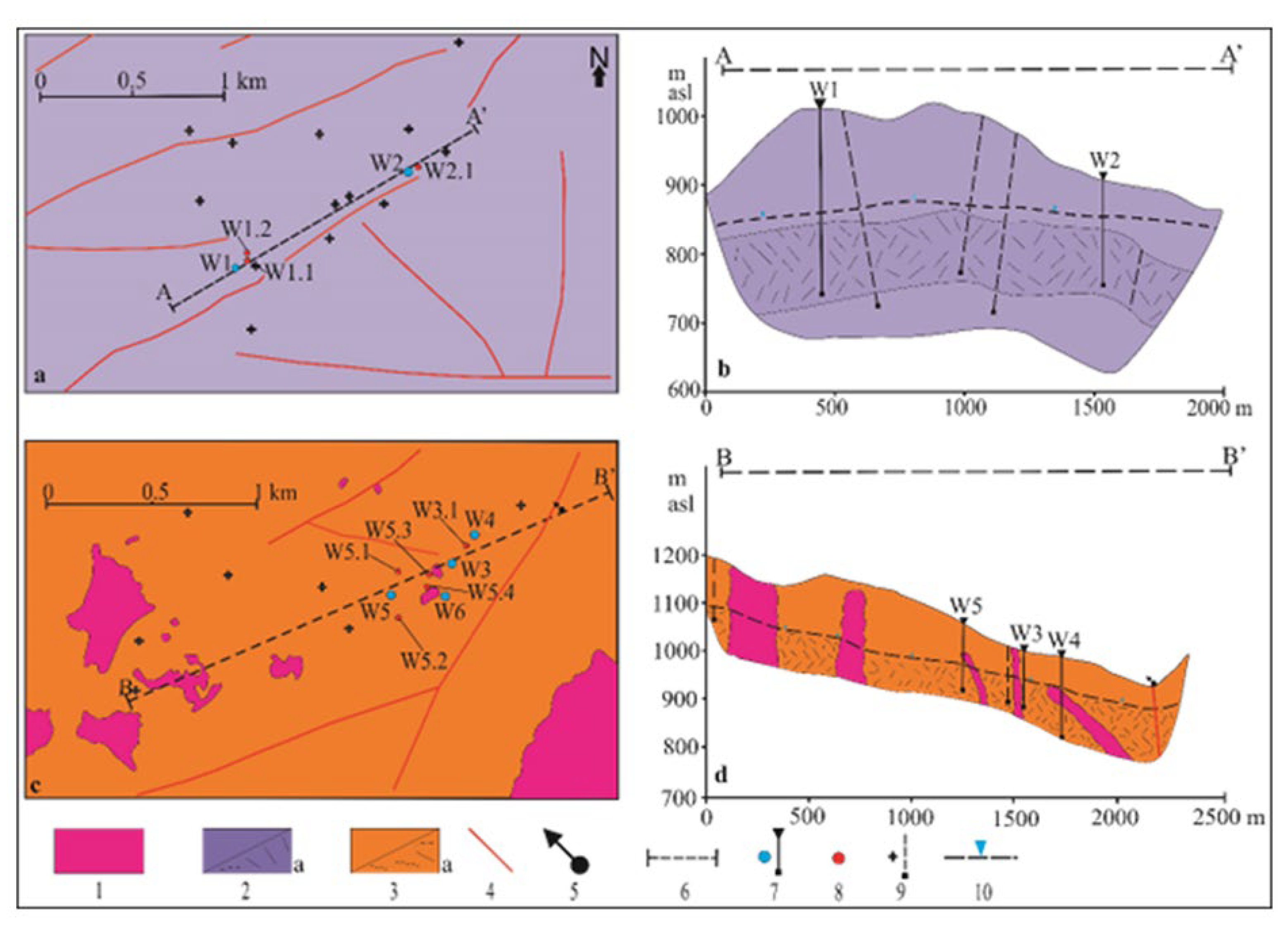
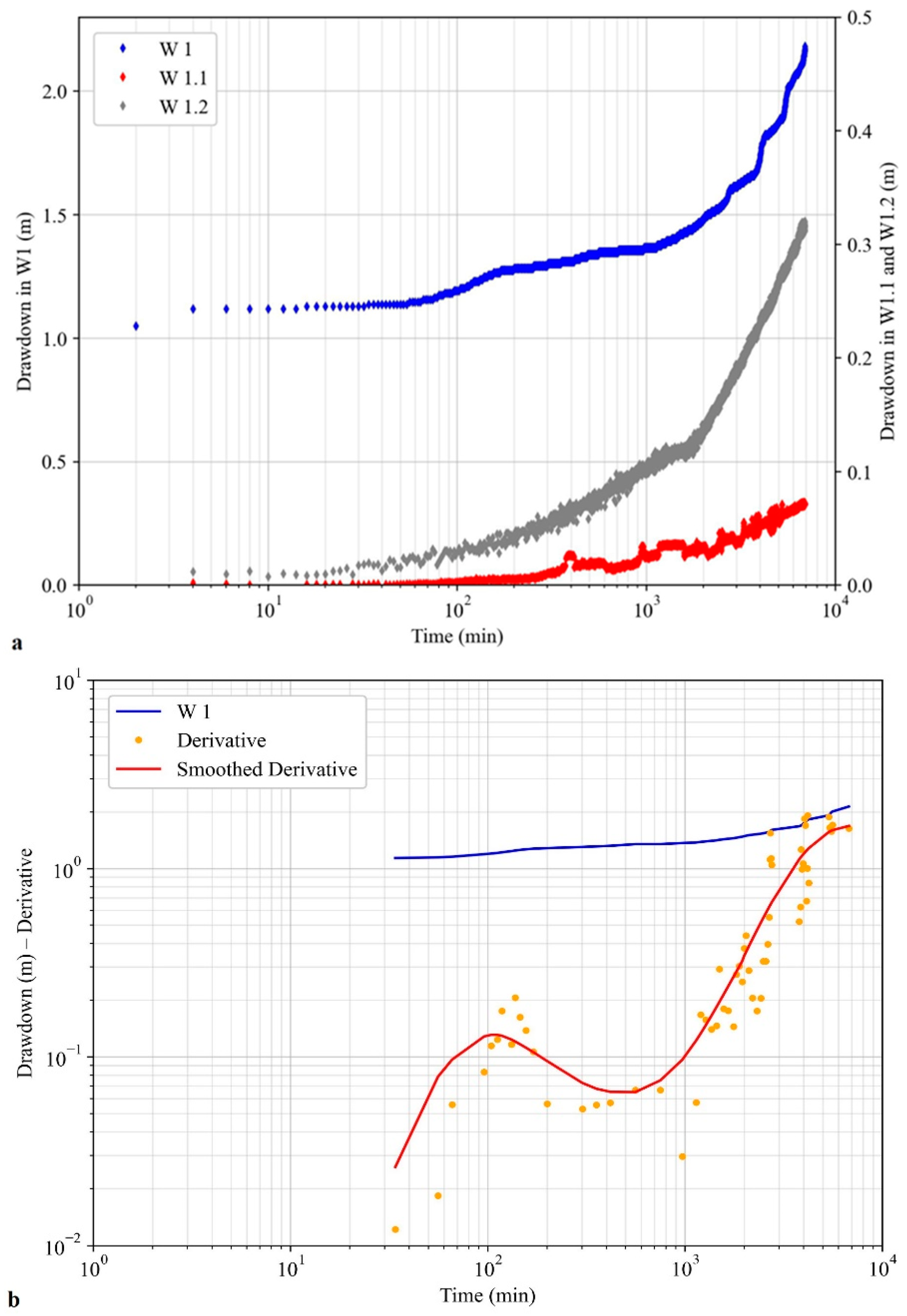
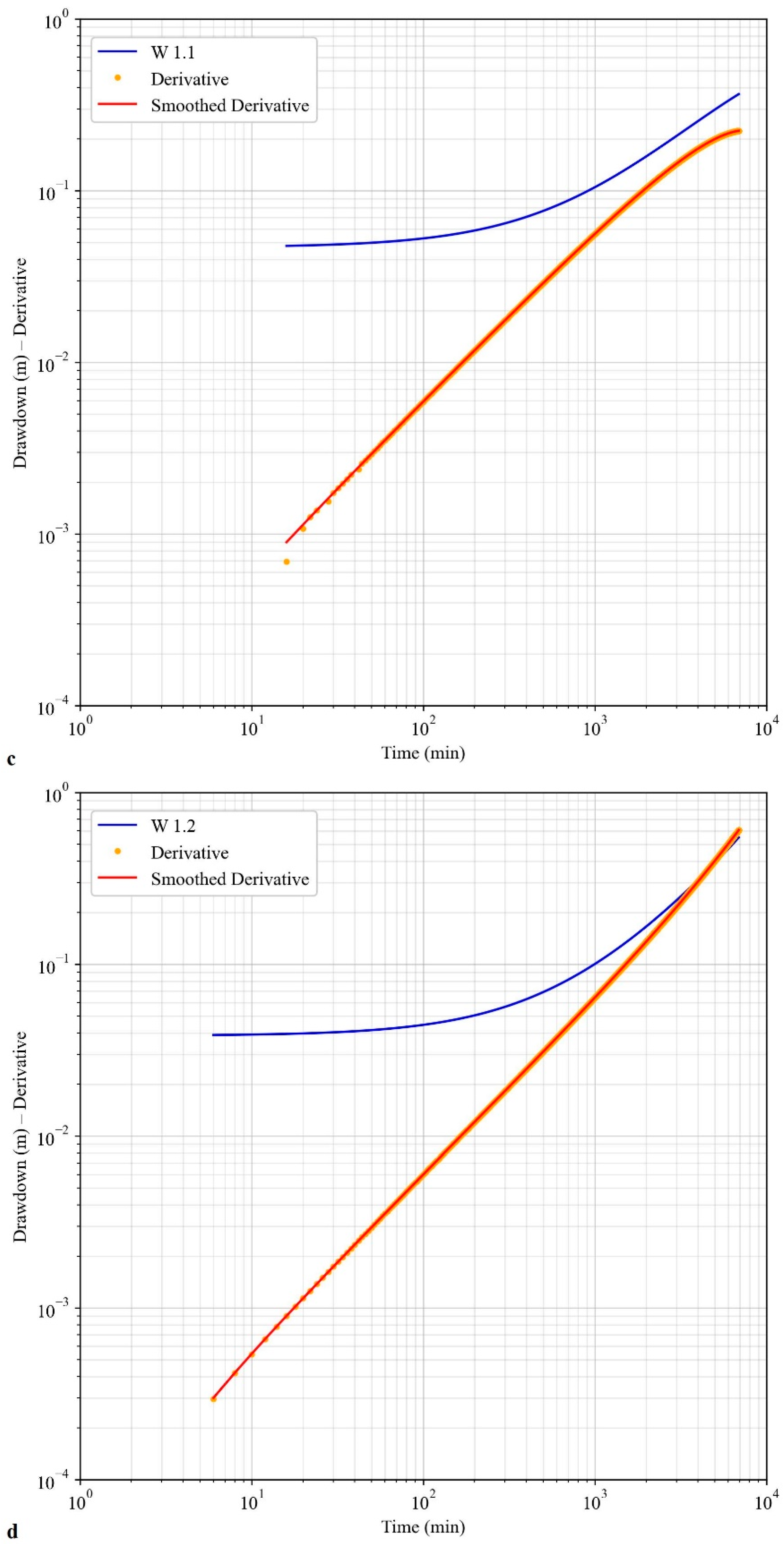
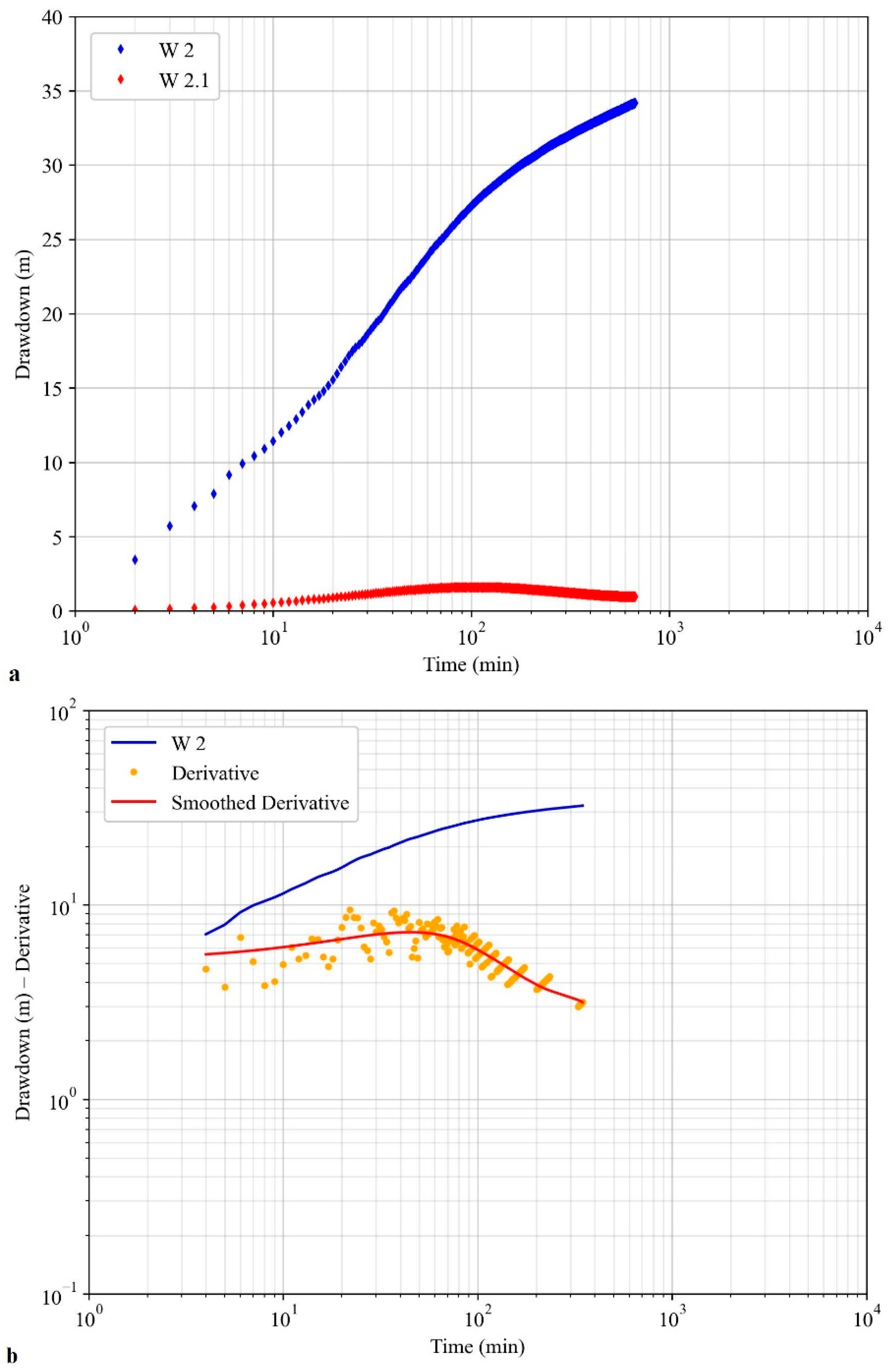
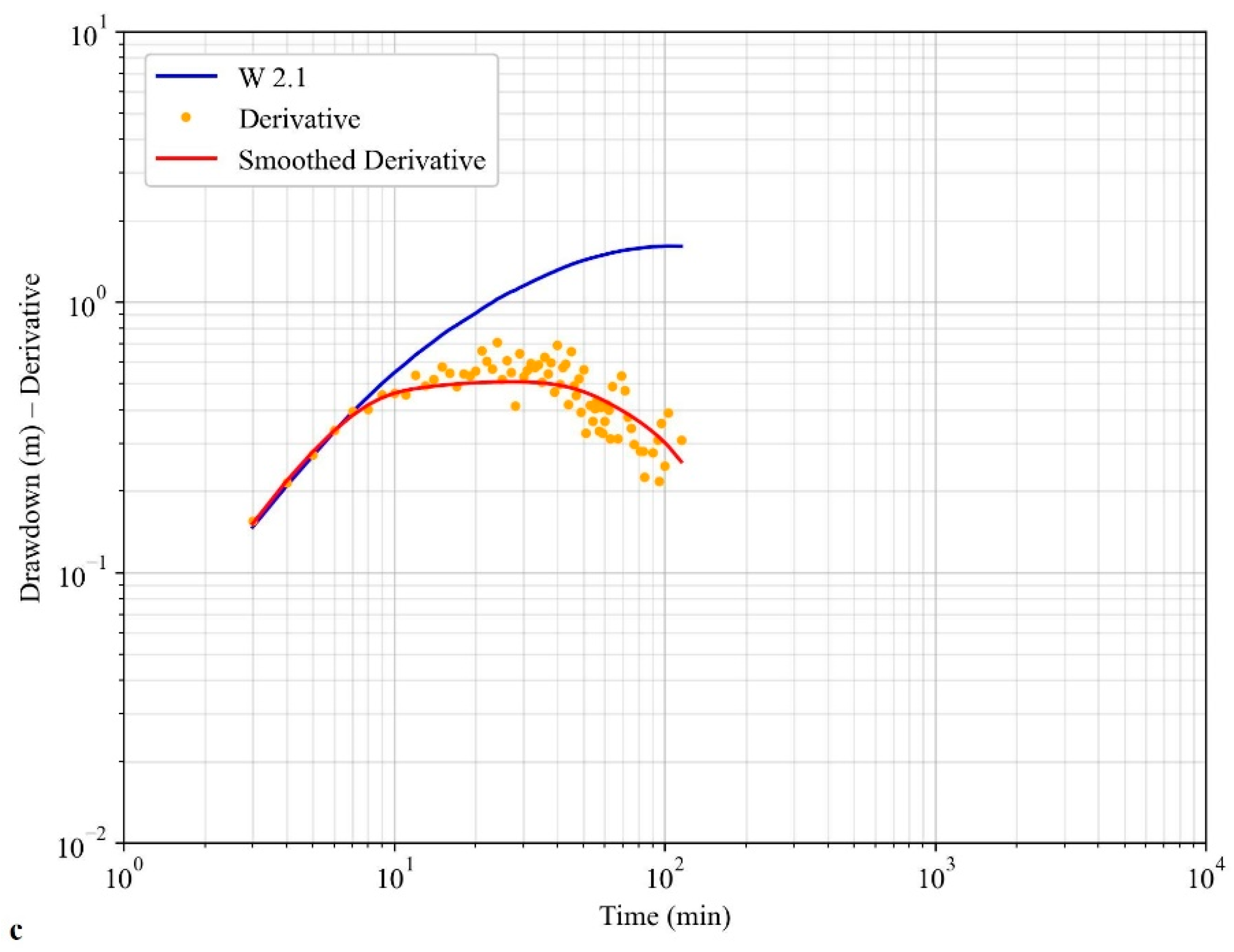
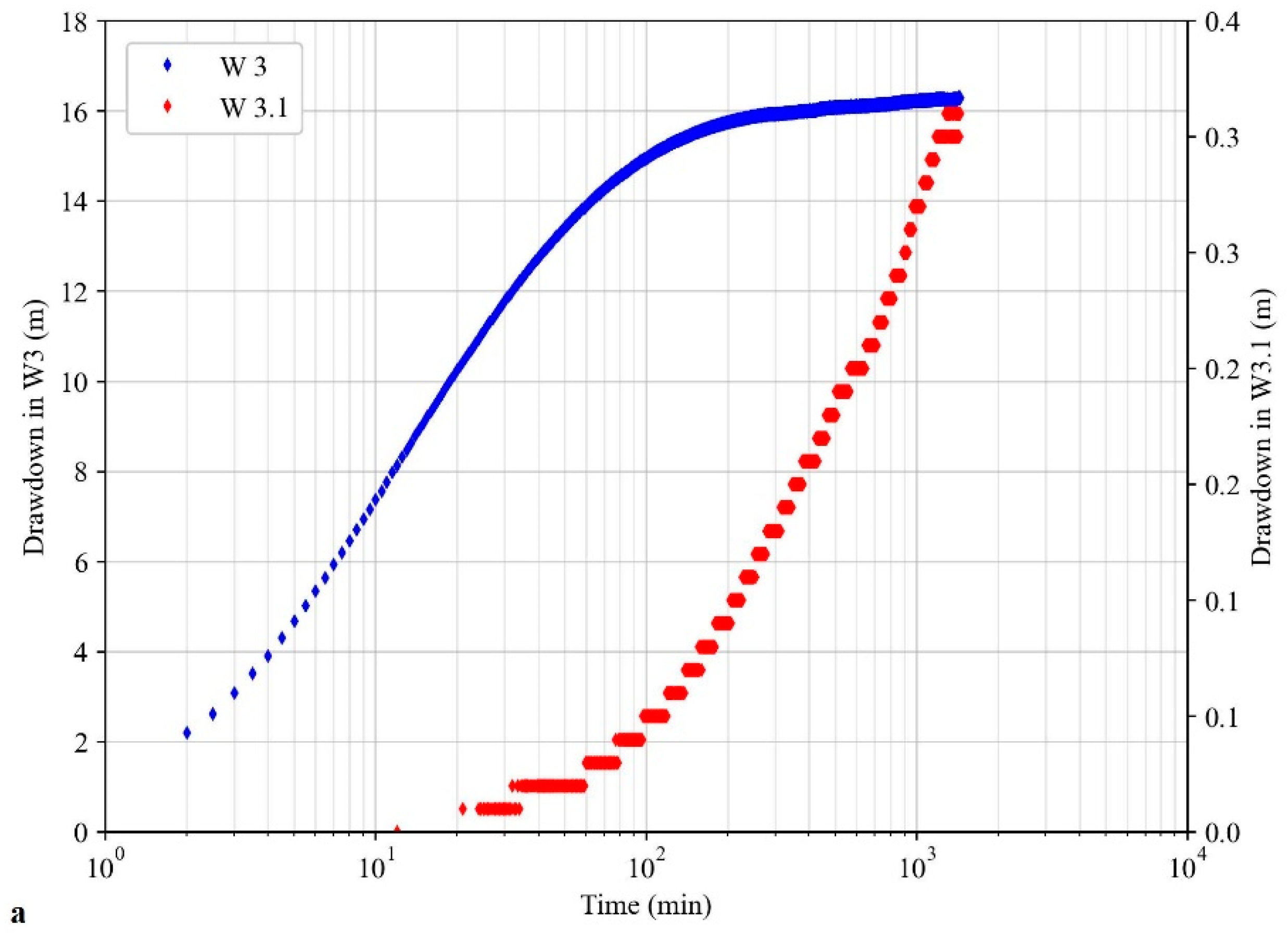
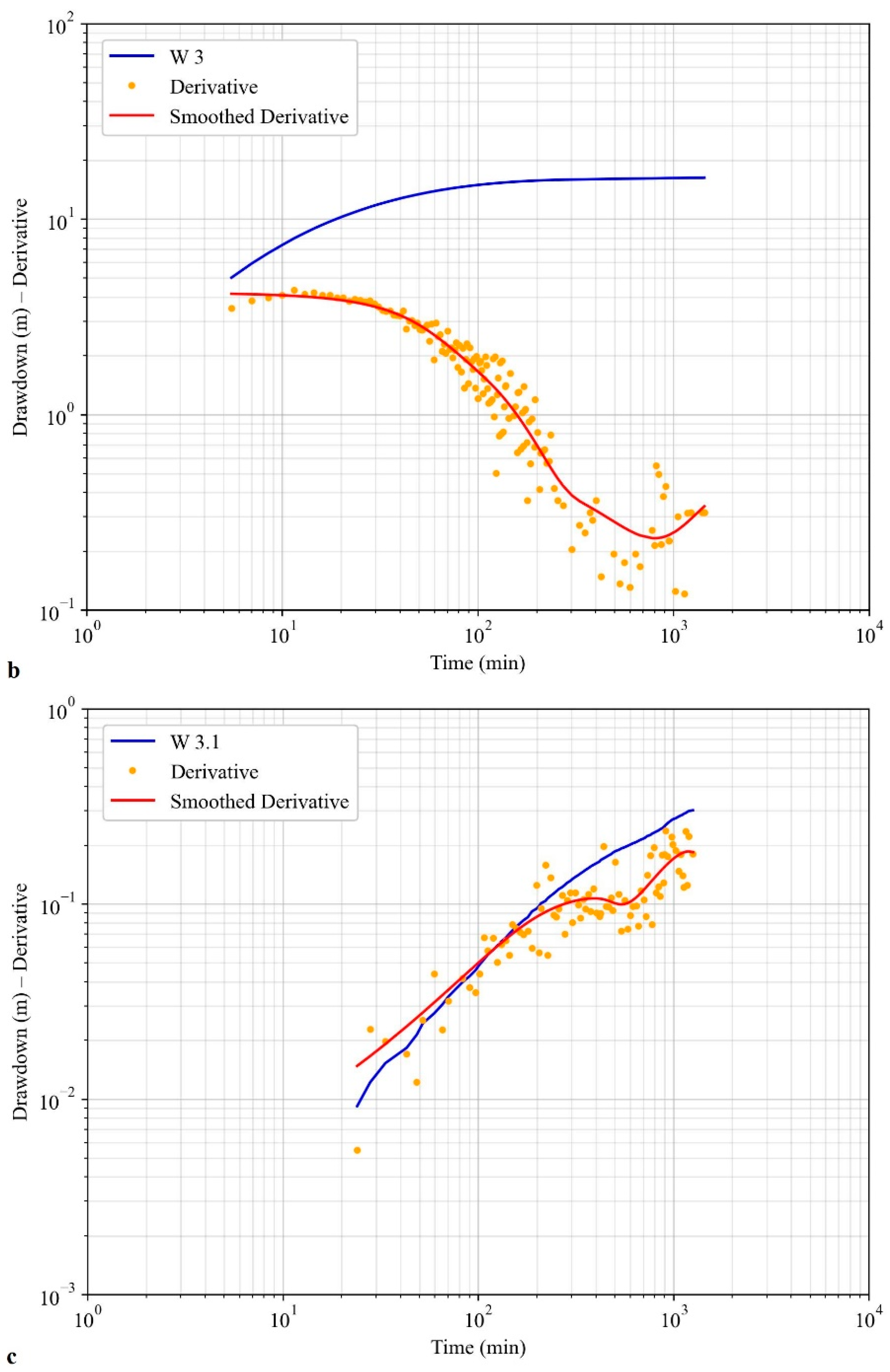
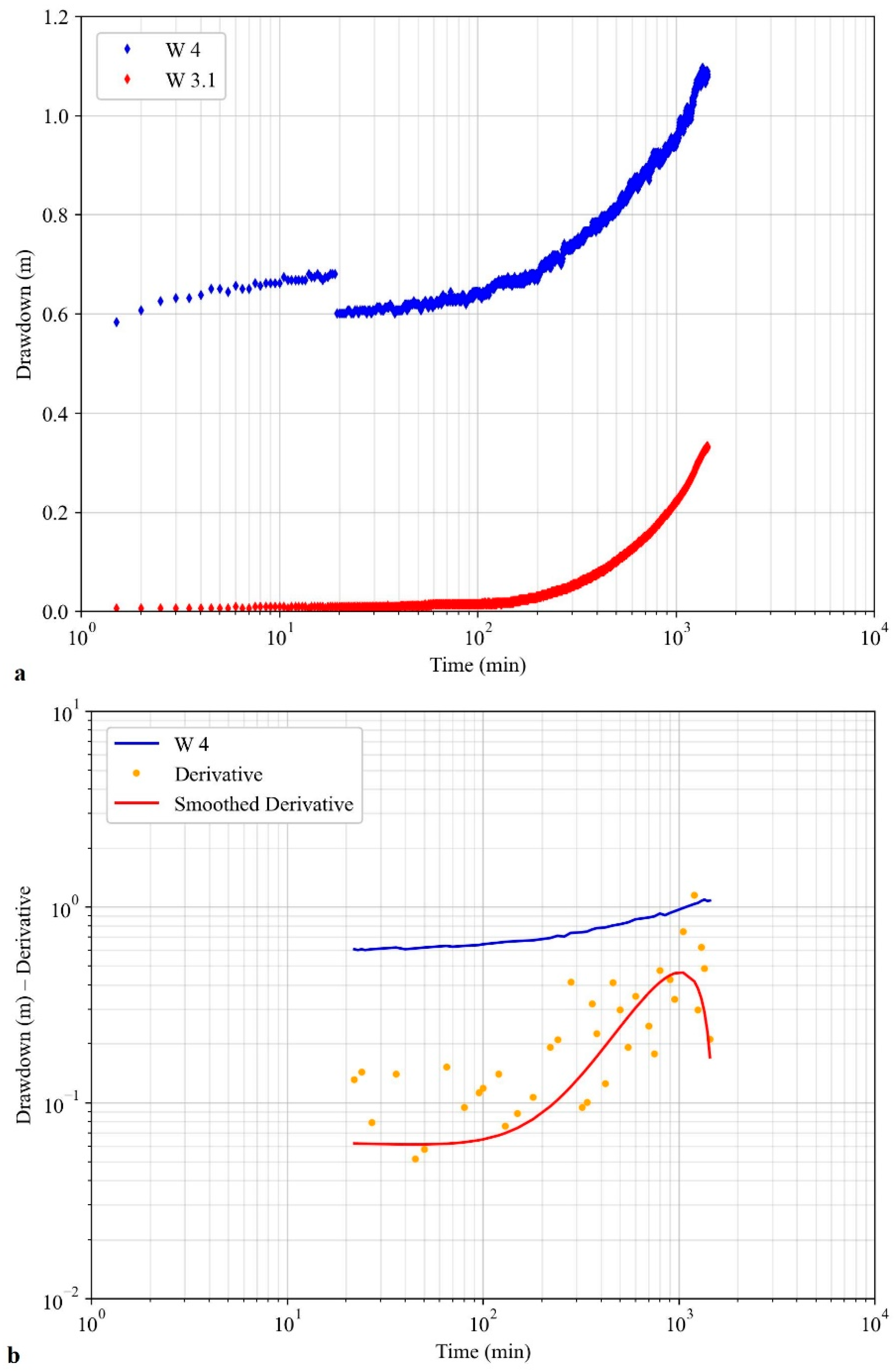
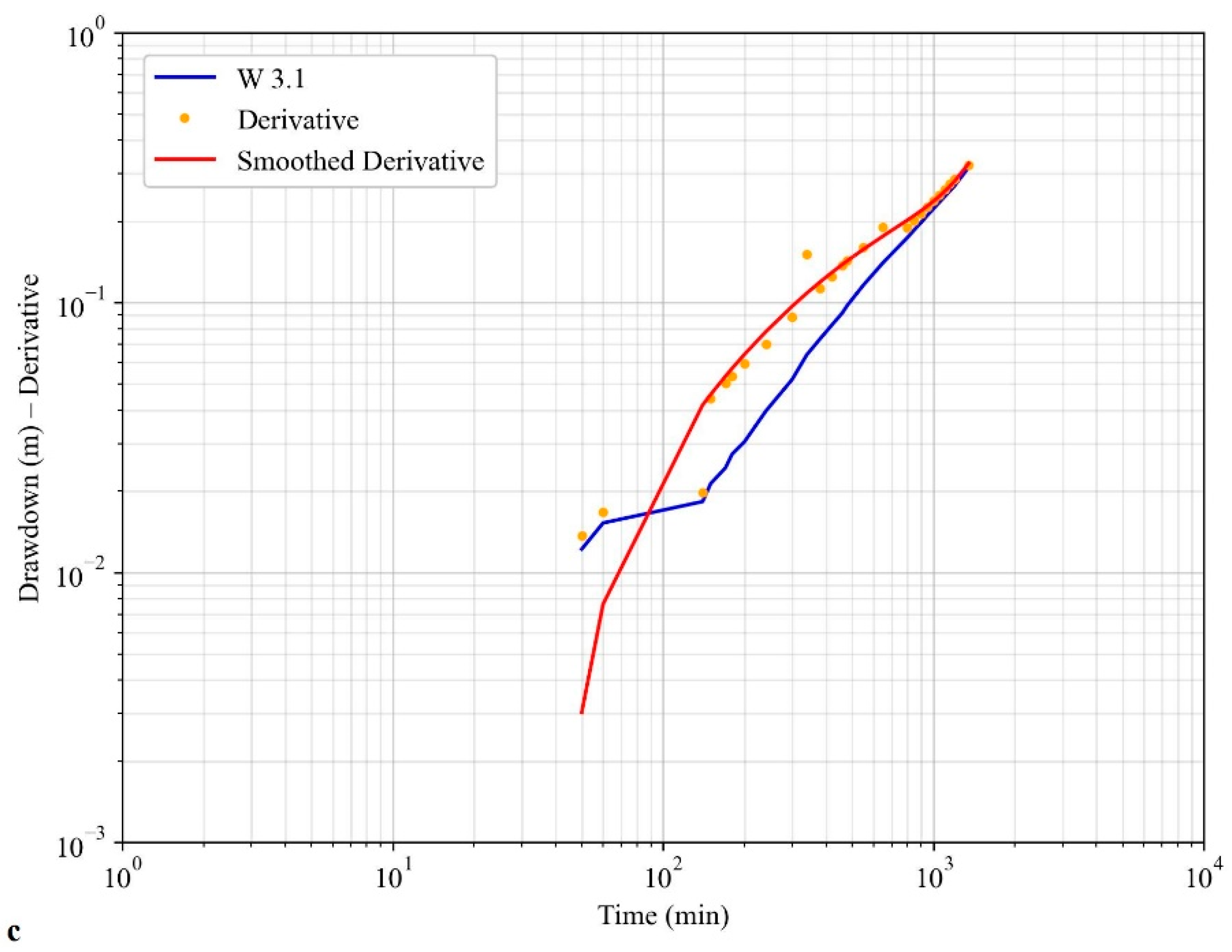

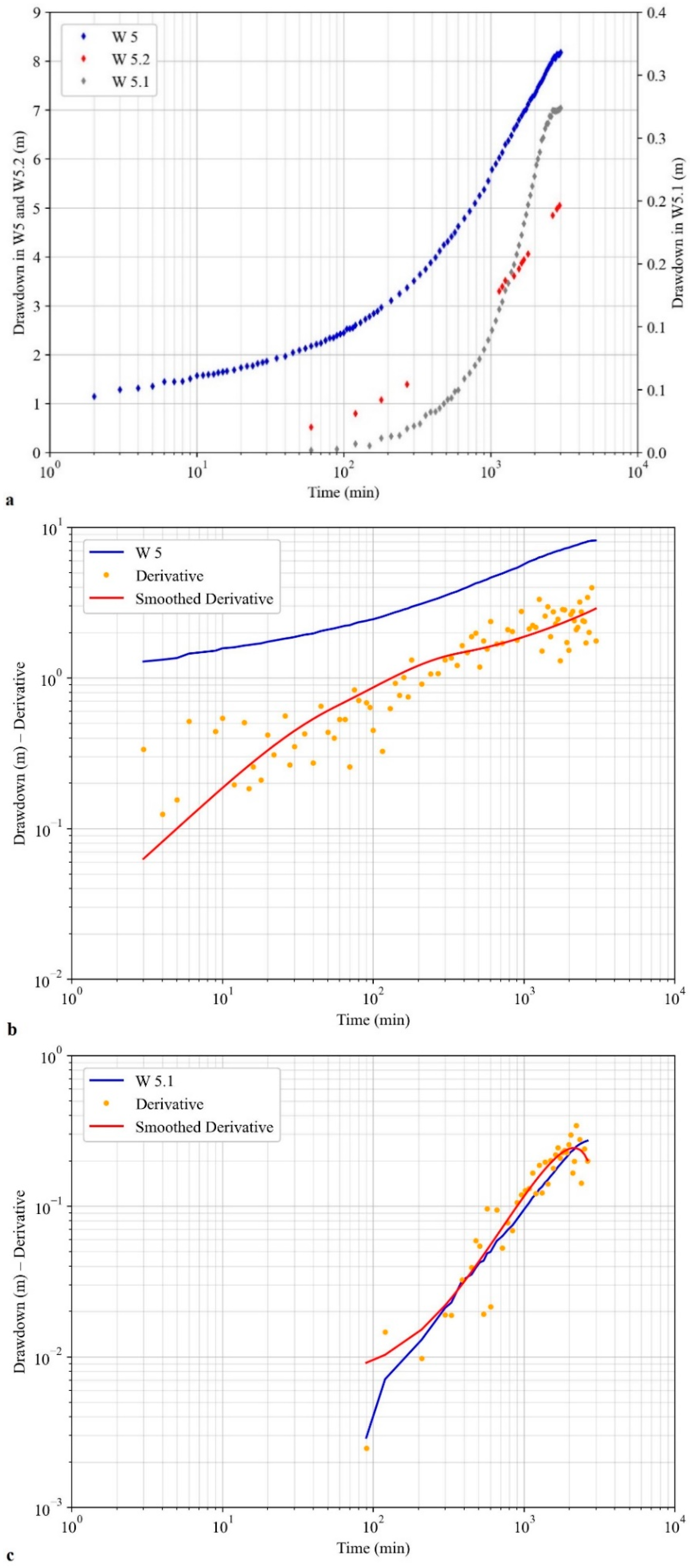
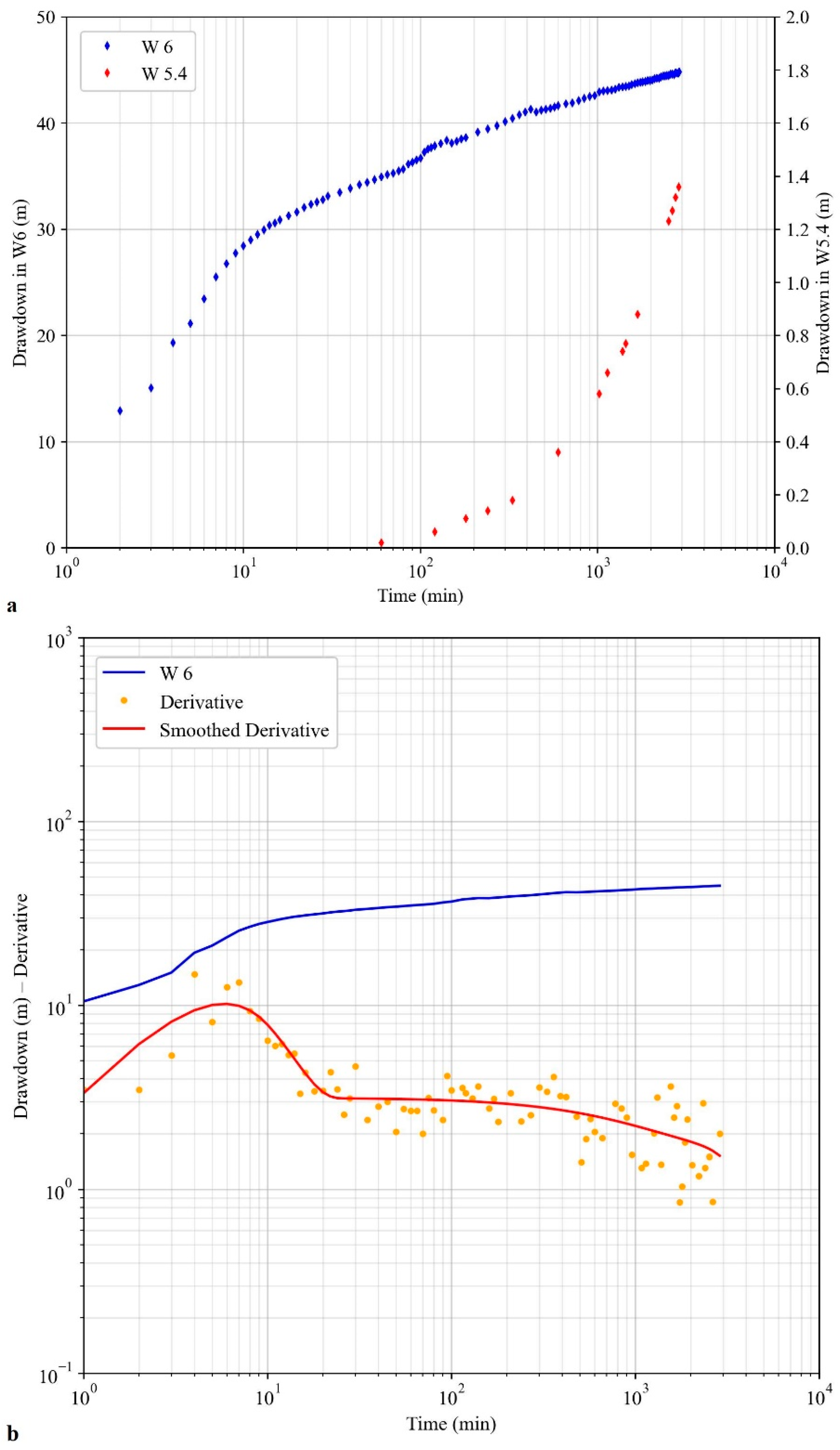
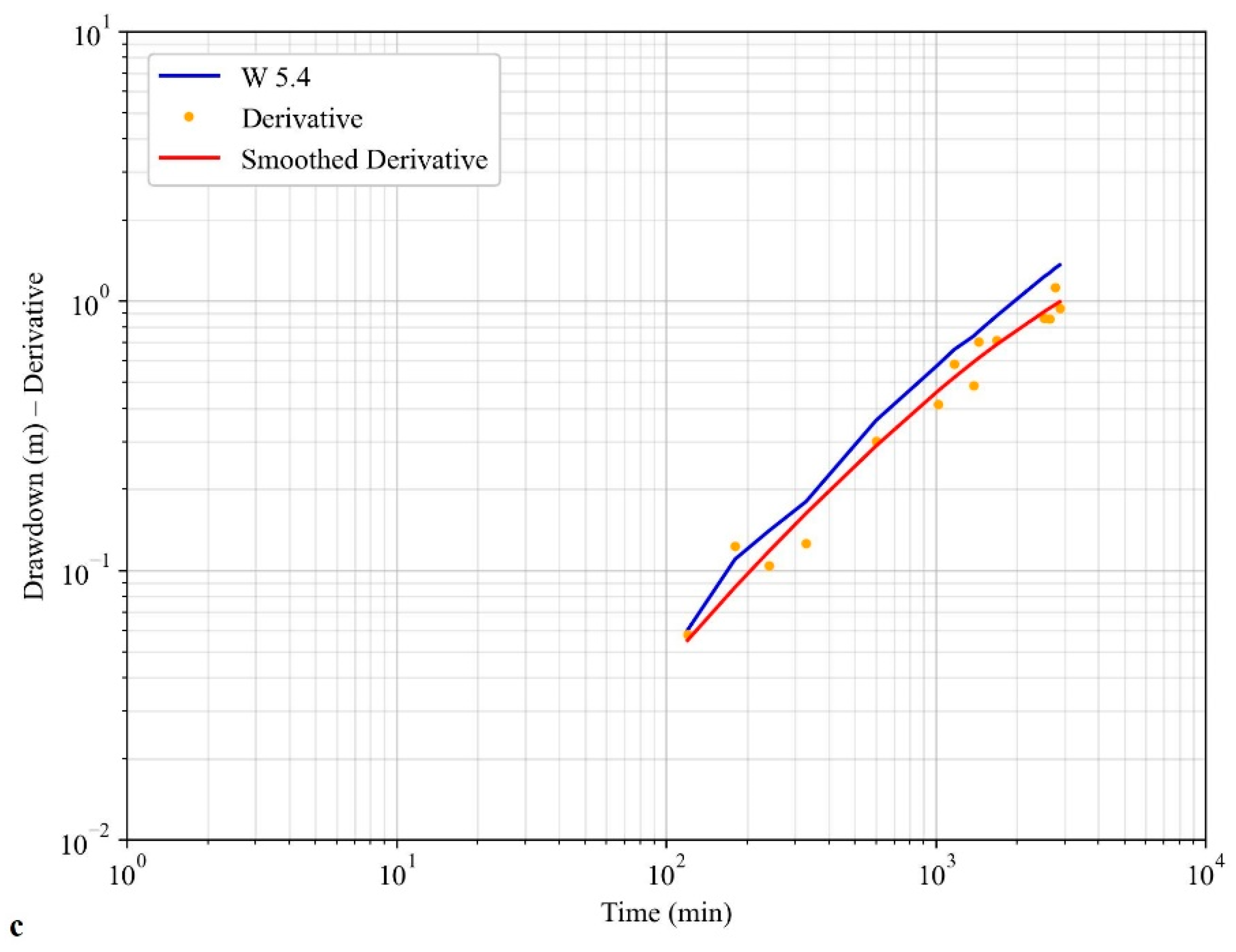
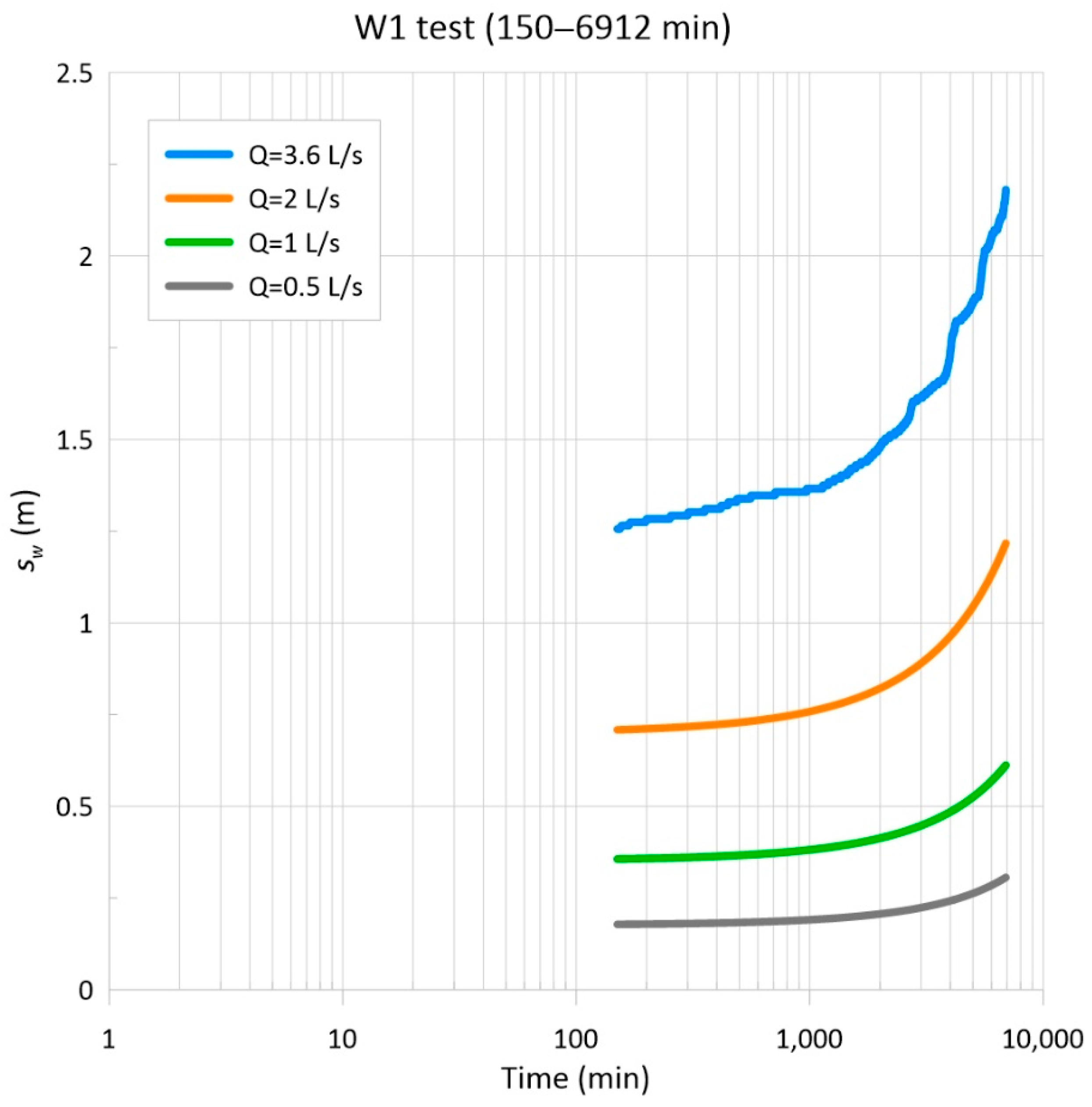
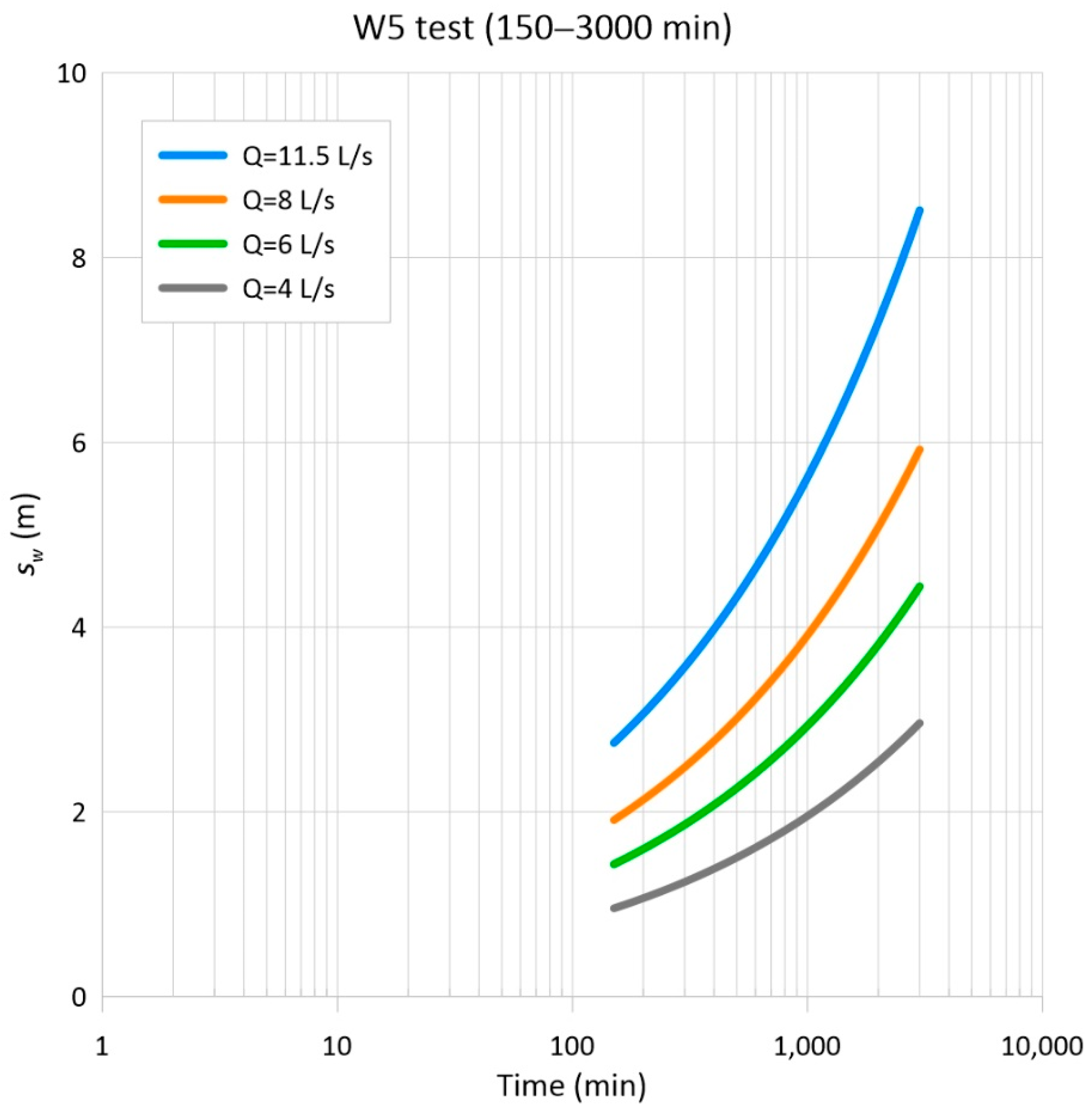
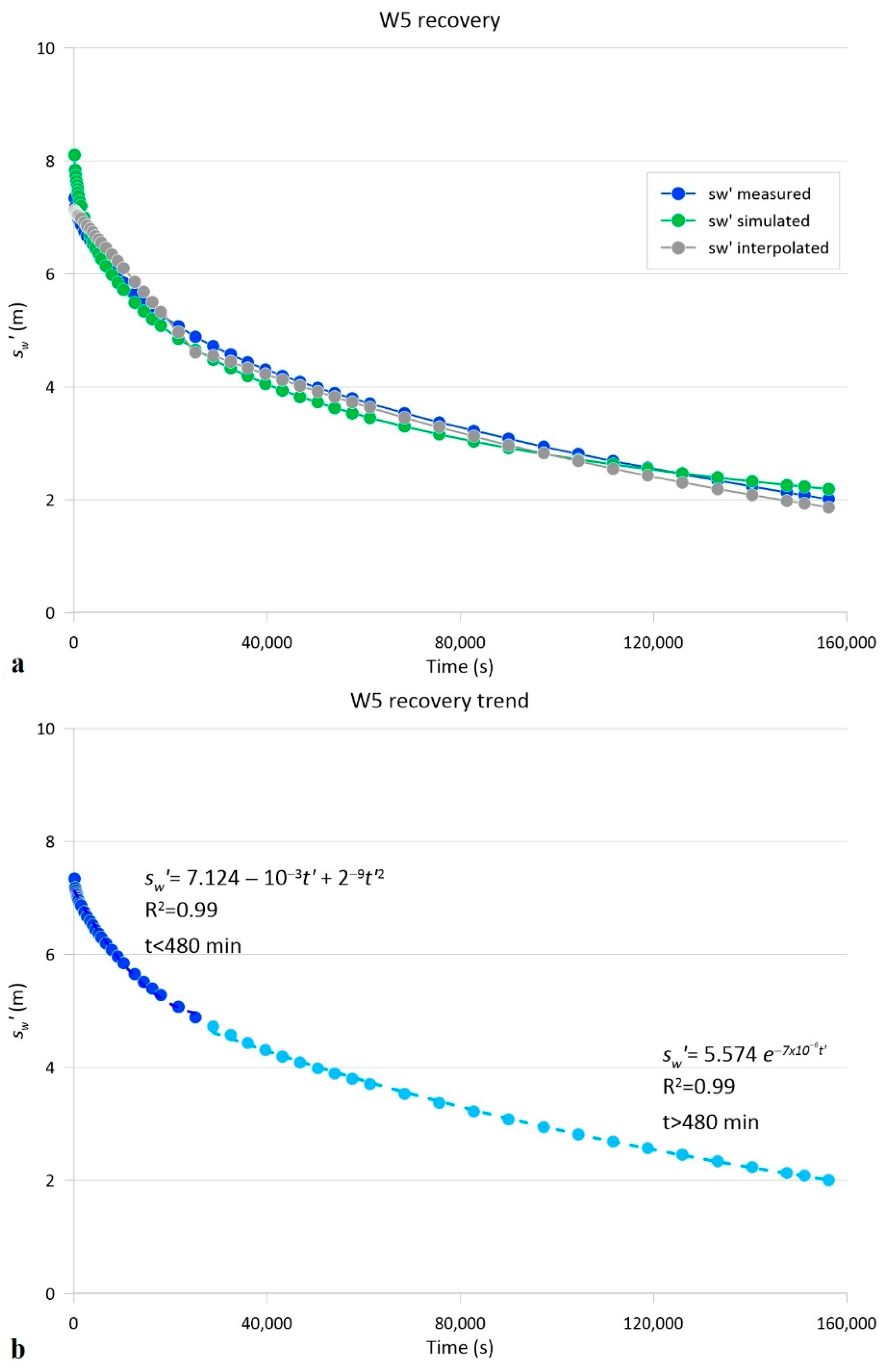
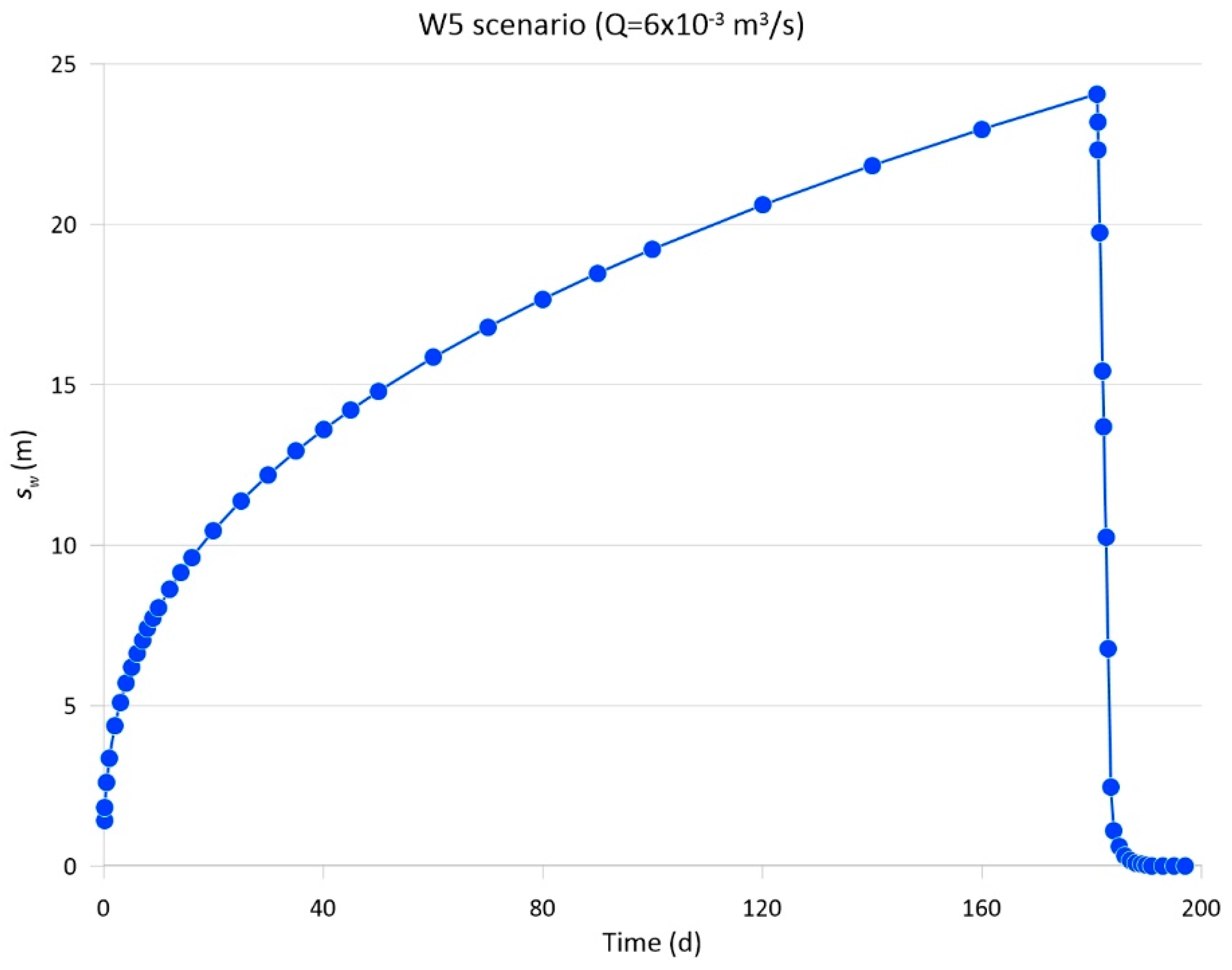
| Well | Aquifer | Depth (m) | Hs (m) | b (m) | Q (L/s) | OW | r (m) | Time (min) | smax (m) | T (m2/s) | S (-) | Tr (m2/s) | Qs (m2/s) | Interpretative Model |
|---|---|---|---|---|---|---|---|---|---|---|---|---|---|---|
| W1 | AND | 267 | 121 | 90 | 3.6 | W1 | 0.16 | 6912 | 2.18 | 3.5 × 10−3 | - | - | 2.7 × 10−3 | No-flow boundary |
| 3.6 | W1.1 | 107 | 6912 | 0.33 | 4.6 × 10−3 | 7.2 × 10−3 | - | |||||||
| 3.6 | W1.2 | 91 | 6912 | 0.32 | 7.8 × 10−3 | 7.9 × 10−3 | - | |||||||
| W2 | AND | 149 | 94 | 90 | 3.9 | W2 | 0.16 | 670 | 34.20 | 8.2 × 10−5 | - | 4.0 × 10−5 | 1.1 × 10−4 | Constant-head boundary |
| 3.9 | W2.1 | 18 | 670 | 0.96 | 5.6 × 10−4 | 8.0 × 10−4 | - | |||||||
| W3 | MET | 121 | 42 | 60 | 7.0 | W3 | 0.15 | 1440 | 16.29 | 1.4 × 10−4 | - | 1.1 × 10−4 | 4.3 × 10−4 | Constant-head boundary |
| 7.0 | W3.1 | 104 | 1440 | 0.31 | 5.3 × 10−3 | 6.0 × 10−3 | - | No-flow boundary | ||||||
| W4 | MET | 167 | 94 | 60 | 15.0 | W4 | 0.15 | 1441 | 1.07 | 6.0 × 10−3 | - | - | 1.6 × 10−2 | No-flow boundary |
| 15.0 | W3.1 | 60 | 1441 | 0.33 | 8.8 × 10−3 | 6.8 × 10−2 | - | |||||||
| W5 | MET | 140 | 58 | 60 | 11.5 | W5 | 0.15 | 3000 | 8.17 | 4.1 × 10−4 | - | 4.8 × 10−4 | 2.0 × 10−3 | Linear flow |
| 11.5 | W5.1 | 110 | 3000 | 0.27 | 1.3 × 10−3 | 3.2 × 10−2 | - | No-flow boundary | ||||||
| 11.5 | W5.2 | 116 | 3000 | 5.05 | 4.7 × 10−4 | 1.2 × 10−3 | - | |||||||
| W6 | MET | 95 | 83 | 60 | 8.7 | W6 | 0.15 | 2895 | 44.81 | 3.5 × 10−4 | - | 4.2 × 10−4 | 2.0 × 10−4 | Radial flow |
| 8.7 | W5.4 | 105 | 2880 | 1.36 | 5.4 × 10−3 | 5.6 × 10−3 | - | No-flow boundary |
| Q (L/s) | Time of Pumping (d) |
|---|---|
| 3.6 | 29 |
| 2.0 | 34 |
| 1.0 | 40 |
| 0.5 | 46 |
| Q (L/s) | Time of Pumping (d) |
|---|---|
| 11.5 | 32 |
| 8.0 | 84 |
| 6.0 | 181 |
| 4.0 | 529 |
Disclaimer/Publisher’s Note: The statements, opinions and data contained in all publications are solely those of the individual author(s) and contributor(s) and not of MDPI and/or the editor(s). MDPI and/or the editor(s) disclaim responsibility for any injury to people or property resulting from any ideas, methods, instructions or products referred to in the content. |
© 2023 by the authors. Licensee MDPI, Basel, Switzerland. This article is an open access article distributed under the terms and conditions of the Creative Commons Attribution (CC BY) license (https://creativecommons.org/licenses/by/4.0/).
Share and Cite
Piscopo, V.; Sbarbati, C.; Dinagde, T.D.; Lotti, F. Practical Approach for Defining the Sustainable Yield of Wells in Low-Permeability Fractured Rocks. Sustainability 2023, 15, 10706. https://doi.org/10.3390/su151310706
Piscopo V, Sbarbati C, Dinagde TD, Lotti F. Practical Approach for Defining the Sustainable Yield of Wells in Low-Permeability Fractured Rocks. Sustainability. 2023; 15(13):10706. https://doi.org/10.3390/su151310706
Chicago/Turabian StylePiscopo, Vincenzo, Chiara Sbarbati, Tolosa Dabi Dinagde, and Francesca Lotti. 2023. "Practical Approach for Defining the Sustainable Yield of Wells in Low-Permeability Fractured Rocks" Sustainability 15, no. 13: 10706. https://doi.org/10.3390/su151310706
APA StylePiscopo, V., Sbarbati, C., Dinagde, T. D., & Lotti, F. (2023). Practical Approach for Defining the Sustainable Yield of Wells in Low-Permeability Fractured Rocks. Sustainability, 15(13), 10706. https://doi.org/10.3390/su151310706







